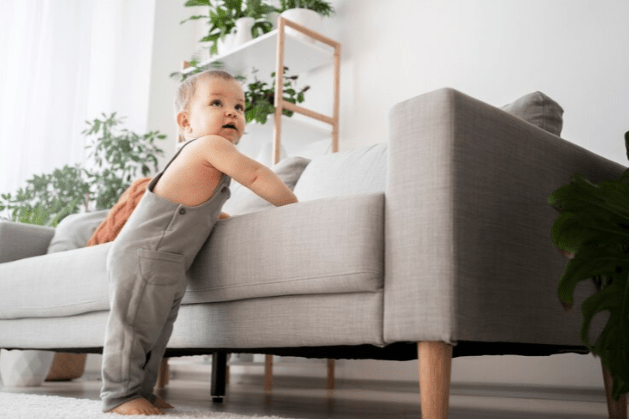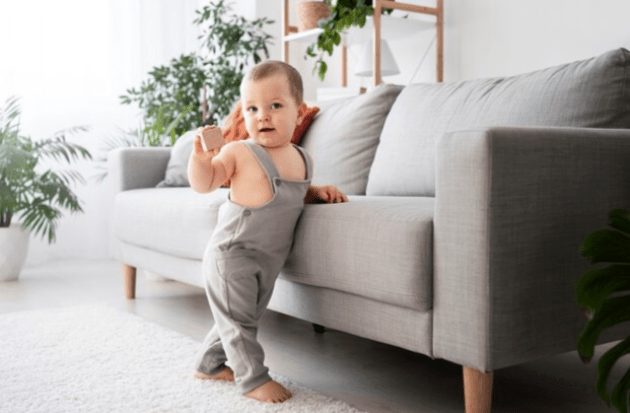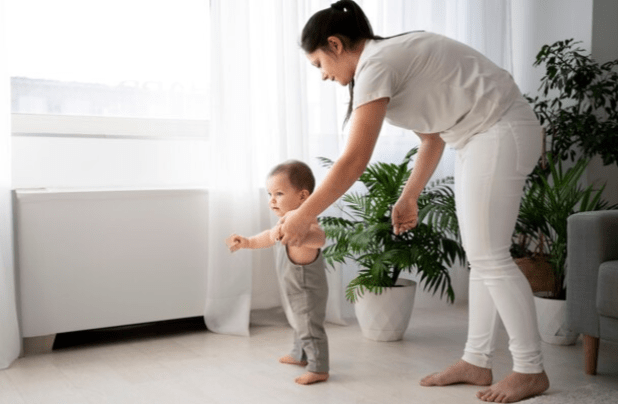Once you bring your baby home, caring for them—and making sure they’re protected—becomes an all-encompassing concern. Childproof home is important part of keeping your baby safe. This is especially key because accidents are the leading cause of injury and death for young children.
Fortunately, by using simple childproofing measures, such as cabinet locks, doorknob covers, and gates for stairs, along with supervision, you can prevent many accidents and tragedies. Learn the best ways to childproof home to keep your little one safe.
How to Childproof Home

While all accidents can’t be avoided, doing your best to make your home safe will help to prevent many of them. There are many steps to follow in order to fully childproof home, including the following:
- Set the temperature of your hot water heater to 120 degrees F.
- Install smoke detectors on every level of your home and near bedrooms.
- Install carbon monoxide detectors near sleeping areas in your homes if you use gas or oil heat or have an attached garage.
- Install covers on electrical outlets.
- Place cushions on the corners of furniture.
- Cut window blind cords or use safety tassels and inner cord stops to help prevent your child from strangling in window blind cord loops.
- Secure furniture and large appliances to the wall, so that your kids can’t tip them over if they climb on them
- Check the floor regularly for small items and toys that younger children can choke on. This includes marbles, balls, uninflated or broken balloons, small magnets, small Lego pieces and other toys with small pieces.
Is your home childproofed?
- Featured Childproofing Products
- KidCo Electrical Safety Assortment Kit
- Safety First Essentials Child-Proofing Kit
- KidCo Electrical Safety Kit Assortment
- Safety First Family Room Child-Proofing Kit
- Safety First 46-Piece Home Solutions Family Room Child-Proofing Kit
- Safety First Outlet Plugs
- KidCo Anti-Tip Furniture Strap
- KidCo Soft Jamb Door Stop – eliminates the removable rubber tips that kids can choke on
- Use outlet covers
- Outlet covers are pieces of plastic that you plug into electrical outlets. They prevent children from playing with electrical sockets and reduce their risk for electrocution.
Install cabinet and drawer locks
Lock all cabinets and drawers that a toddler or young child could reach. Cabinet and drawer locks can prevent small children from accessing dangerous chemicals and implements, including:
- Kitchen and bathroom cleaners.
- Laundry detergents.
- Lawn and garden chemicals.
- Medicines.
- Outdoor cleaning supplies.
- Sharp objects such as knives, kitchen scissors or garden shears.
You can find locks and other styles at any store that has a baby section. Hardware and home improvement stores sell them, too, or you can order them online. Child safety lock prices generally range from $3 to $20. Some options include:
Cabinet and drawer latches
A latch automatically locks the cabinet or drawer when it closes. It attaches easily to the inside of most drawers and cabinets with screws. Pressing a tab releases the cabinet or drawer from the catch. But if your children see you unlock it enough times, they may figure out how to do it themselves.
Cabinet flex locks
A flex lock attaches to cabinet handles or knobs to keep the drawer or cabinet door closed. A flexible tab and triple touch release features give added protection.
Magnetic locks
A magnetic lock keeps doors and drawers shut and requires a key to open them. This lock is more difficult to install, and you’ll need to keep an extra key.
It’s also best to keep chemicals both out of reach (think a top shelf) and locked away.
“Child cabinet locks are not foolproof,” says Dr. Giuliano. “A savvy toddler may be able to break them. Storing chemicals out of reach prevents an accidental exposure if somebody forgets to relock the cabinet.”
Avoid cords on blinds and drapes
Dr. Giuliano says window blinds cords pose a significant strangulation risk.
“When they dangle, they can be enticing to a child — and they often dangle right at their hand and eye level,” she says.
To childproof your window treatments, choose blinds that:
- Don’t have cords.
- Have retractable cords.
- Have devices you can wrap the cords around to prevent them from dangling.
Babyproofing the Nursery
Here are some areas in your little one’s nursery or bedroom that need special attention. Follow these babyproofing tips to help keep your baby safe:
Crib
Your baby spends a lot of time in their crib and is usually unattended, so making it a completely safe sleep environment is important. Keep the crib free of soft materials like bumpers, pillows, blankets, and stuffed animals, as these increase the risk of suffocation, as well as any eliminating cords or decorations that your little one might get caught in. Ensure the crib meets all current safety standards, such as crib slats being no more than 2 3/8 inches apart, and use a firm, flat, tight-fitting mattress. Here are some of the best baby cribs as selected by Pampers parents.
Bed
If your child can climb out of their crib, it’s time move them from the crib to a low bed or a mattress on the floor. If you have bunk beds for your older children, don’t allow a child under 6 years to sleep on the top bunk. Check out some of the best toddler beds, chosen by Pampers parents.
Changing table
You must be extra vigilant to prevent falls when selecting and using a changing table. Look for a table that’s sturdy and has a two-inch guardrail on all sides, and find a changing pad with a concave middle. You can use the safety strap during changes, but even if you do, keep one hand on your wriggly baby at all times. Don’t ever leave your baby unattended on the table, even for a second. Store diapers and diapering supplies close by but out of your little one’s reach.
Toy box
Use a toy box or basket without a lid or cover, to prevent your child from getting stuck inside or trapping their little fingers.
Babyproofing the Bathroom
The bathroom can be a busy place for your little one, who may be splashing in the bathtub, brushing their teeth, or using the toilet like a big kid. These activities come with some risk, which is why you must always supervise young children in the bathroom. Here are some additional precautions and childproof home ideas:
Install cabinet locks
Just like in your kitchen, you can use child- and babyproof cabinet door locks to keep all cosmetics, cleaning products, and medicines out of your child’s reach.
Practice bathtub and water safety
Never leave your little one unattended in the bath. Drowning is a risk, even in a few inches of water. Other safety strategies include applying nonslip pads on the bottom of the tub and placing a cushioned cover over the faucet to help provide a safe and fun bath time for your toddler. To make sure your child isn’t scalded by water that’s too hot, you can adjust the temperature of your water heater, as well as always testing the bath water before your child gets in the tub.
Close and/or lock the toilet
Remember to close the toilet lid after use and even babyproof it with a lock to prevent your curious toddler from trying to explore.
Babyproofing the Living Room

This cozy space for the entire family may have some unexpected dangers. Try these babyproofing hacks for your living room:
Cover sharp corners
Put corner guards on table edges and any other sharp edges to prevent painful knocks and scrapes.
Use cordless window coverings
Having curtains and blinds without cords can prevent your child from getting tangled in them. If you do have cords, wrap them around wall brackets or attach them to floor mounts.
Screen the fireplace
If you have a fireplace or a woodburning stove in your home and you’re wondering how to babyproof it, first of all, you could consider using a screen in front of it. Never leave your child unattended in a room with a fire and make sure older children understand the dangers of putting things in a lit fire or playing close to a fire. Putting screens on radiators may also prevent burns.
The Bottom Line
At all stages of development, from baby to young teen, children bring with them different levels of activity, knowledge, and adventure. And keeping your little one safe is a top priority. That’s why babyproofing or childproofing your house is crucial to help prevent accidents in the home.
We have provided some key childproof home tips that may help you along the way, such as using gates on stairs, locking or latching cupboards and drawers containing dangerous items, placing outlet covers on all electrical outlets, and securing and mounting large unstable furniture to the walls, to name a few.
Considering your child’s safety outside of the home is also important. You may also be interested in learning about toddler bike safety to keep your little one safe even when on the go. With our helpful babyproofing and parenting tips, your journey through parenthood can be made a little easier.
We hope you found this information helpful in your journey to create a safer environment for your family. At GuardWell Safety, we understand that every home is unique, and so are your child-proofing needs. That’s why we offer a Free Child-Proofing Consultation tailored to your specific requirements. Let our experts help you identify potential hazards and provide personalized solutions to make your home a secure haven for your little ones. Book your free consultation today and take the first step towards peace of mind.






